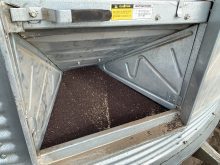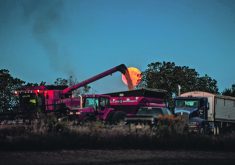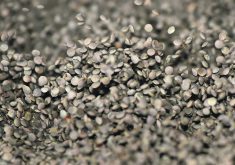University of Manitoba researchers have concluded that farmers should not store wet canola in grain bags because canola at 14 percent moisture content begins to spoil after only six weeks.
“Fourteen percent moisture content is not a moisture content at which you should be storing canola in these bags under Manitoba conditions or, I would say, Canadian conditions,” Digvir Jayas, vice-president of research and a grain storage scientist at the U of M, told the Manitoba Canola Growers Association annual meeting in Brandon in late February.
However, Grain Bags Canada president Aaron Yeager of Lake Lenore, Sask., said Jayas’ conclusion doesn’t reflect the on-farm reality in Western Canada.
Read Also

Farming Smarter to hold Agronomy Battles series
Southern Alberta non-profit research institute hope grassroots sessions with producers help focus future research on cover crops, strip tillage and herbicide resistance
“I don’t agree with that,” said Yeager, who conducted a grain bagging demonstration for canola growers at Brandon meeting.
“Hundreds of farmers in Saskatchewan will prove that wrong.”
Yeager said he has bagged canola on his farm at 15 percent moisture content in the fall and not taken it out of the grain bag until the following June. A tiny fraction of the crop had spoiled, but almost all of it was fine, he said.
Bernie Schloorlemmer, who farms near Rycroft, Alta., said he regularly stores tough canola in bags.
“The bottom line is if it’s tough, we put it in a bag; if it’s dry we put it in a bin,” said Schloorlemmer. “We have a big farm and we don’t even own a dryer; we have such confidence in putting tough grain in bags.”
However, Jayas isn’t convinced.
In October 2010, he and other U of M researchers loaded 20 tonnes of canola into grain bags to see how long the oilseed could safely be stored. The bags were filled with canola with eight, 10 and 14 percent moisture content.
The scientists collected data on temperature and carbon dioxide inside the bags as well as grain samples to monitor for spoilage.
The dry canola and the 10 percent moisture content canola looked good when the scientists unloaded the bags in August 2011.
“Eight percent moisture content canola was stored safely for a 10 month period and we think it could be stored longer than that,” Jayas said.
“And 10 percent moisture content canola also stored reasonably well.”
However, the canola that went into the bags at 14 percent moisture content had to be removed with a front end loader because significant caking had occurred.
“Most of that grain went for animal feed,” Jayas said.
Having concluded that 14 percent canola is too wet for grain bags, Jayas and his team began another bagging experiment last fall, looking at canola with 12 percent moisture content.
Yeager, whose company worked with U of M researchers and said he respects what they’re trying to accomplish, noted their results were skewed because they likely didn’t seal the grain bags properly.
“For grain to spoil it needs oxygen. So if you’ve got everything sealed off, it won’t spoil,” Yeager said.
Despite his reservations, Jayas agreed that grain bags can reduce the time and cost of trucking grain to a bin in the farmyard and the bags can be used to store overflow.
Yeager said farmers renting land or producers looking to retire don’t have to spend money on steel bins if they bag their grain.
“Why would you want to buy a bin for land you don’t even know you’re going to have in three years?”
Yeager admitted one drawback of leaving large plastic bags in a field is that ravens like to poke holes in them.
Despite that issue, he said many farmers in Canada must believe that grain bags are a viable option to steel bins because industry sales are “doubling every single year.”
For more information on sealing grain bags properly, check with your local grain bag dealer because companies provide different guidelines on how to close bags.
















